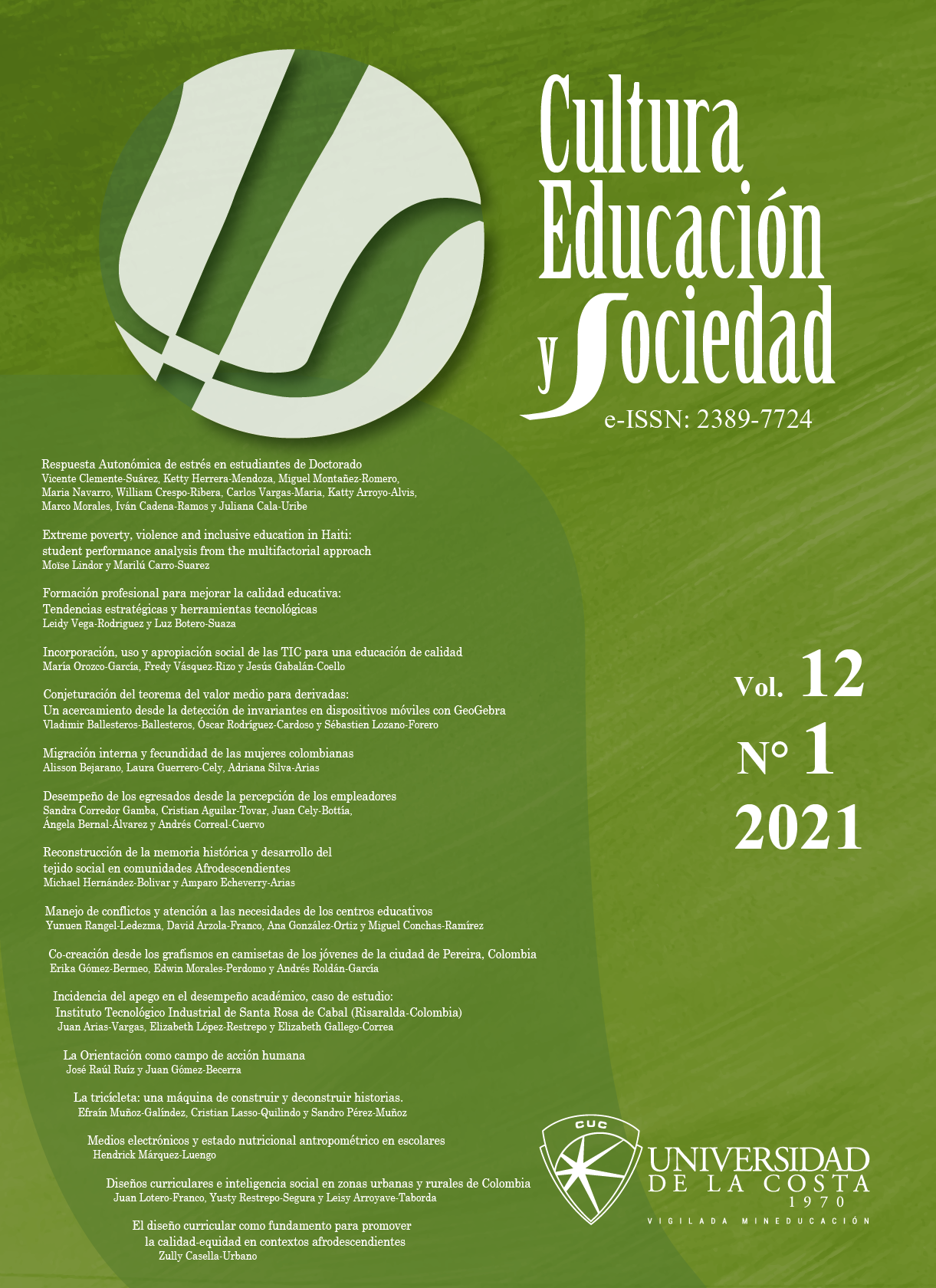Professional training immersed in digital transformation in order to improve quality in education
DOI:
https://doi.org/10.17981/cultedusoc.12.1.2021.03Keywords:
Digital transformation, Professional training, Integral training, Technological innovation, Pedagogical trendsAbstract
The use of technologies has been considered an efficient way to improve the transfer and appropriation of knowledge. Under the new paradigm of Industry 4.0, it is necessary to redirect the teaching-learning process towards an education based on technologies that contribute to the development of creative and reflective thinking, from the strengthening of creativity, innovation, autonomy, collaboration, imagination, interactivity and entrepreneurship. As a result of technological surveillance over the education sector, analyze emerging technology trends supporting teaching-learning and creative research, as well as the more specific challenges facing the education system, in order to promote digital transformation and innovation technological. The information presented serves as a reference and guide to improvement planning, supporting or expanding teaching, learning and research
Downloads
References
Alexander, B., Ashford-Rowe, K., Barajas-Murphy, N., Dobbin, G., Knott, J., McCormack, M., Pomerantz, J., Seilhamer, R. & Weber, N. (2019). EDUCAUSE Horizon Report: 2019 Higher Education Edition. Louisville: EDUCAUSE. Available: https://eric.ed.gov/?id=ED603350
ANDI, Innpulsa y VTSAS. (2018). Cierre de brechas de innovación y tecnología. [Online]. Recuperado de http://www.andi.com.co/Uploads/Estudio%20Cierre%20de%20
Brechas%20Innovacion%20y%20Tecnologia-ilovepdf-compressed.pdf
Burgelman, R., Christensen, C. & Wheelwright, S. (2009). Strategic Management of Technology and Innovation [3 Ed.]. Boston: Mcgraw-Hill Education.
Cluster de Prendas de Vestir. (15 de junio de 2019). Validación de programas de formación para el sector textil. [Online]. Disponible en https://www.ccb.org.co/Clusters/Cluster-de-Prendas-de-Vestir/Noticias/2019/Julio-2019/Validacion-de-programas-deformacion-para-el-sector-textil
CRUE. (2017). TIC 360°. Transformación Digital en la Universidad. Madrid: CRUE Universidades Españolas. Recuperado de https://tic.crue.org/wp-content/uploads/2016/03/transformacion-digital-univ.pdf
Díaz-Barriga, Á. (2015). TIC en el trabajo del aula. Impacto en la planeación didáctica. Revista Iberoamericana de Educación Superior, 4(10), 3–21. https://doi.org/10.1016/s2007-2872(13)71921-8
Freeman, A., Adams, S., Cummins, M., Davis, A. y Hall, C. (2017). Resumen Informe Horizon. Edición 2017. Educación Superior. [NMC/CoSN Horizon Report: 2017 K–12]. Austin: The New Media Consortium. Recuperado de https://intef.es/wp-content/uploads/2017/12/2017_1105_Horizon2017_Prim_Secund_INTEF.pdf
García-Valcárcel, A. (2007). Herramientas tecnológicas para mejorar la docencia universitaria. Una reflexión desde la experiencia y la investigación. Revista Iberoamericana de Educación a Distancia (RIED), 10(2), 125–148. Disponible en http://revistas.uned.es/index.php/ried/article/view/996
Grajek, S. & Grama, J. (2018). Higher Education’s 2018 Trend Watch and Top 10 Strategic Technologies. Louisville: EDUCASE. Retrieved from https://library.educause.edu/resources/2018/2/higher-educations-2018-trend-watch-and-top-10-strategic-technologies
Guevara, L. y Castellanos, Ó. (2000). Incidencia de la tecnología blanda y la tecnología dura en el desarrollo industrial de la biotecnología en Colombia. INNOVAR, Revista de Ciencias Administrativas y Sociales, (15), 79–94. Disponible en https://revistas.unal.edu.co/index.php/innovar/article/view/24210
Johnson, L., Adams, S., Cummins, M., Estrada, V., Freeman, A. y Hall, C. (2016). NMC Informe Horizon 2016 Edición Superior de Educación. Austin: The New Media Consortium. Recuperado de http://www.aprendevirtual.org/centro-documentacion-pdf/2016-nmc-horizon-report-HE-ES.pdf
Lester, J., Klein, C., Johri, A. & Rangwala, H. (2018). Learning Analytics in Higher Education. New York: Imprint Routledge. https://doi.org/10.4324/9780203731864
República de Colombia. MinTIC. (2019). Plan Estratégico Institucional MINTIC 2019-2022. [Versión Borrador]. Recuperado de https://www.mintic.gov.co/portal/604/articles-82084_plan_estrategico_institucional_mintic_2019_2022.pdf
SENA. (marzo 20 de 1997). Estatuto de la Formación Profesional del Servicio Nacional de Aprendizaje. [Acuerdo 08]. Disponible en https://hdl.handle.net/11404/1610
UNESCO. OREALC. (2013). Enfoques Estratégicos Sobre Las TICs En Educación en América Latina y el Caribe. Santiago de Chile: Unesco. Recuperado de http://www.unesco.org/new/fileadmin/MULTIMEDIA/FIELD/Santiago/images/ticsesp.pdf
Published
How to Cite
Issue
Section
License
Copyright (c) 2020 CULTURA EDUCACIÓN Y SOCIEDAD

This work is licensed under a Creative Commons Attribution-NonCommercial-NoDerivatives 4.0 International License.
![]()
Creative Commons 2020 CULTURA EDUCACIÓN Y SOCIEDAD
This article is under international license Creative Commons Reconocimiento-NoComercial-SinObrasDerivadas 4.0.
The published articles are the sole responsibility of their authors and do not necessarily reflect the opinions of the editorial committee.
CULTURA EDUCACIÓN Y SOCIEDAD respects the moral rights of its authors, who assign to the editorial committee the patrimonial rights of the published material. In turn, the authors inform that this work is unpublished and has not been previously published.
All articles are under a:
Licencia Creative Commons Atribución-NoComercial-SinDerivadas 4.0 Internacional.
![]()


 English
English
 Español (España)
Español (España)




_12.53_.27_p_. m_._3.png)





_12.57_.35_p_. m_._3.png)
_12.50_.37_p_. m_._3.png)



